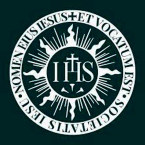Jesuit Brother Wenceslas Soto explained that the emblem of the Society of Jesus IHS, present on the coat of arms of Pope Francis' Pontificate, represents that Jesus is the beginning and foundation of spirituality and although it is explained as the abbreviation of 'Jesus the Savior Man', this is a devotional tradition that adds to the original meaning.
Specifically, he has indicated that it is the monogram resulting from the abbreviation of the name 'Jesus' in Greek: I√ß√≥ou√≤ or IH√ďOU√ď next to a Greek 'eta' (√ß, H). By assimilating this sigma into a Latin 'ese' (s, S), and in capital letters, you get IHS.
The set, Soto said, was covered with a horizontal outline to indicate that it is an abbreviation. When writing the monogram in lowercase Gothic letters (ihs), the vertical stroke of the 'h' intersected with the horizontal of the abbreviation, forming a cross. This custom was maintained with capital letters, adding to the set a cross over the H, sometimes with the image of Christ crucified or with the Child Jesus.
In addition, he pointed out that it is also very common to include the IHS within a radiant sun, surrounded by a crown of thorns, or with other iconographic accessories and has pointed out that this sign was already widely used before the foundation of the Society, as an expression of devotion to the name of Jesus, and was sculpted on the cover of many houses. as a heraldic shield.
As he pointed out, the emblem was disseminated by the Dominicans and Franciscans, among whom St. Bernardine of Siena (1380-1444) stood out. But its greatest diffusion came with the Society of Jesus. Ignatius headed his letters from the first days in Manresa with the name or abbreviation of Jesus, which he used to write with four lowercase letters, putting the cross on the vertical pole of the 'h'. He also adopted it as his seal of General Provost of the Company, adding under the monogram a crescent moon between two stars.
"It is thought to be a symbolic, heraldic representation of the firmament, but it could also be reminiscent of the sun and moon present in the medieval iconography of Calvary," he added. However, he indicated that it is "much more frequent" in the Society of Jesus to place under the monogram three keys joined by their tips, which are those of the passion of Christ, whose origin is also medieval.
Likewise, he remarked that from the sixteenth century it was very common to add a choir on which the three nails rest and although the addition of the choir was not exclusive to the Jesuits, they were the ones who used it most. In fact, St. Ignatius is usually depicted contemplating an IHS (like other Jesuit saints) or inscribed either on his chest or on some object he holds (book, banner, ostensory).
Likewise, it became very frequent on the covers of books, in the houses of the Order as an identifying and decorative element (wherever there were people of the Society it was necessary to name Jesus), and on the stamps or logos of his works.
Soto said proof of his media power is that Charles III, expelled from the Jesuits, ordered all IHS removed from occupied buildings and the royal coat of arms put in place.


Afegeix-hi un comentari: